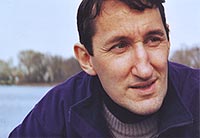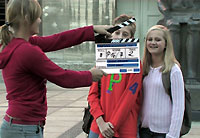|
Interview with Director Michael Gautsch!

How was “The Little School of Behaviour – Part 1” received?
The acceptance rate is extremely high; if this wasn’t the case, it wouldn’t have been possible and we wouldn’t have wanted to produce a second film for the series.
How did part 2 of “The Little School of Behaviour” come about?
When researching for part 1, I noticed then that I wouldn't be able to find place for all the important content in just one episode. We had to limit ourselves to a certain selection. Additionally, some teachers and headteachers made us aware of different content matters that they would like to see being dealt with in a similar film. For example, the behaviour of school students under peer pressure, students who wear inappropriate clothes to school or children who steal to gain attention and acceptance from fellow schoolmates. We have happily seized upon such suggestions.
What are the main points focussed on in the new episode?
The phenomenon of the so-called “problem child” - children who often bring problems from home into the school. Problems such as parental divorce issues can go on to affect the behaviour of the child. This can be seen in part 2 - how argumentative Max's parents are and how this puts a lot of strain on the young boy. This time we have especially focused on bullying, when bigger children pick on smaller children for no apparent reason. I found out from a scientific investigation that almost every second child would at some point during their time at school be a victim of such wrongdoing. What's shocking is the fact that such incidents occur mostly around the age of ten. Another focus of this film is shoving to get onto the bus and a class trip to a museum.
Did the concept of contrasting good and bad behaviour in individual chapters prove successful?
Yes, the division of the film into chapters allows teachers to show the film chapter by chapter in multiple lessons rather than having to play the whole film through in one class. One headteacher told me, that she'd even used specific chapters for different age groups. That shows, that the films are even more flexible for use in lessons than we had thought.
In the positive version, you show how Max first confides in his school friend Julia and then in his teacher about his parent's marriage problems, enabling him to find a solution to his problem. In doing so, the film goes far beyond the classic demonstration of good behaviour.
Absolutely, part 2 especially looks at correct social behaviour. Good behaviour comes as a result of correct social conduct. Demonstrating good behaviour works best when embedded in a social context.
Both child actors from part 1 play the same roles in part 2. The teacher is however new, taking over from the previous actor.
I made this amendment for the purpose of the content: I wanted to portray a dynamic young teacher who, in comparison to the teacher in part 1, stays on top of things and has the class under control. Someone who is strict but fair, who supports the children but is also faced with her own limitations.
Because she can't do anything to stop Max's theft and the salesman announces that he will have to inform the police?
Yes. It is intentional, by the way, that the theft scene takes place outside of the school. At school, a theft could be dealt with internally and the police wouldn't necessarily have to be called. With this, the film also hints at what comes after school: the outside world – where there are no longer such sheltered places like schools.
Were you able to watch part 1 of the film with students as a class?
As we were preparing for part 2 and came into contact with the school classes who took part in part 1, I often had the opportunity to discuss the film in detail with students.
How was the film received?
The film was a hit with the children. It spoke the same language as them and their reactions were lively. The conversations confirmed to me that the film is a good introduction into this field, but that it should be embedded with preparatory and follow-up talks, if it is to be not only entertaining but also a source of ongoing discussion.
As the director, how long where you involved in making part 2?
Part 2 took four months. The research and conception took about six weeks, a further four weeks were needed to prepare for the filming, which after two disruptions lasted over three weeks. The film editing and post-production required a further five weeks.
Why does the research and conception require so much time?
Ultimately, we need so long because we want it to be noticeable. That means, the children watching should be able to identify with the characters within the individual scenes. In order to achieve this, we have to carry out extremely thorough research and hold many one-on-one interviews. It's also important that as many children as possible actually find themselves in the portrayed situations. For example, in part 2, we wanted to broach the issue of cheating in a test. Before we could create this scene, we had to know what teachers do when they catch a student cheating. So we asked some teachers and were astonished at how differently they would each handle the situation. Some would just take away the cheat sheet or any other cheating aid and let the student carry on writing, whilst others would take a much harder stance. A strange response came from one teacher who thought, students could cheat as long as she didn’t catch them doing so. Since cheating is commonplace in the real world, in which the students will be released.
Which raises the question, which values are conveyed by such an attitude?
To me, such a statement reflects an understanding of values that is, at best, based upon getting one over on someone else. If your opponent can get the better of you, then it makes sense. In any case, to convey such an attitude was not a possibility for our film. We do not resign ourselves to the deceit in the world, instead we shape the world in which we live. And making an effort to respect one another and not to intentionally defraud people play a part in the shaping of the world.
Which scene from part 2 did you personally like the most?
The one where Max confides in his teacher. It's probably the most important scene in the film. It shows the children that it takes courage to confide in a teacher but it is also the sensible thing to do. This scene was also brilliantly acted by both actors – the young boy, who already showed talent in part 1, has now excelled himself.
How was the filming?
Very stressful, even though you wouldn't notice watching the film. Eight school classes were used for this film. That's about 200 schoolchildren. And so when the cameras weren't rolling, it was always very loud on set and there was constant coming and going.
You were the first film crew to be allowed to film inside the world famous Pergamon Museum?
We were told that producers of feature films have until now only been met with refusal. The museum administration made an exception for us because it was also in their interest that an educational film exists, showing children how they should behave in a museum. If we had have come a month later, the filming would not have been possible since there would have been no more days available when the museum would have been closed.
Did you have to do the filming when the museum was closed to the public?
Yes, we had the museum all to ourselves.

|